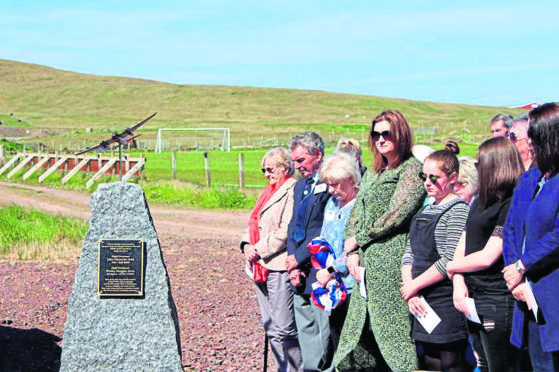There was an air of poignancy amid the sunshine in Cunningsburgh at the weekend as the local history group unveiled a new memorial commemorating the loss of a de Havilland aircraft at Royal Field in 1944.
Pilot John Alexander Reid and navigator Wesley Douglas Irwin died on November 22 when the Mosquito DZ642 crashed into the hills in poor visibility.
The aircraft was short of fuel as it attempted to fly to Sumburgh from a mission to the German U-boat pen at Trondheim, Norway.
Some of the remains of the plane can still be seen alongside a stone memorial at the crash site, which can be accessed by foot from Sandwick, but Cunningsburgh History Group was keen to mark the site closer to the community in the village.
A well-attended service in the sunshine outside the group’s history hut near to the hall saw an opening speech from chairwoman Pat Christie before Lord Lieutenant of Shetland Bobby Hunter gave some context to the isles’ wartime links.
There were also words from Terry Mayes, who provided background to the fateful mission, as well as RAF Lossiemouth squadron leader Bryan Parsons, the Reid family and reverend Neil Brice.
The memorial, which is made out of Norwegian stone and is topped off by a small metal Mosquito plane, was unveiled by the Irwin family before wreaths were laid on behalf of RAF Lossiemouth and RAFA Shetland.
The history group received £9,500 from the Heritage Lottery Fund to put towards erecting the memorial.
Christie said it was “very important” for Cunningsburgh to pay tribute to the two men who died.
“It was the community who came to us as a history group and said we really want this,” she said.
“We’d been on a walk to the memorial, but it’s a long difficult walk, and people wanted to see something that was accessible to everybody.
“So it’s very important to us both as a history group, and to the community and to the families.”
The Cunningsburgh history hut, which features a special Mosquito display, will be open every Sunday between 2pm and 5pm until September 2.
